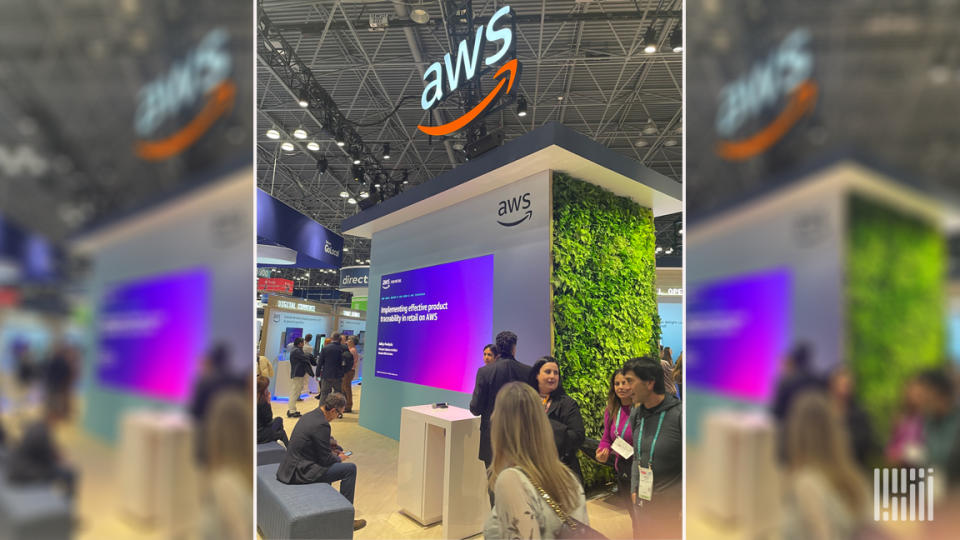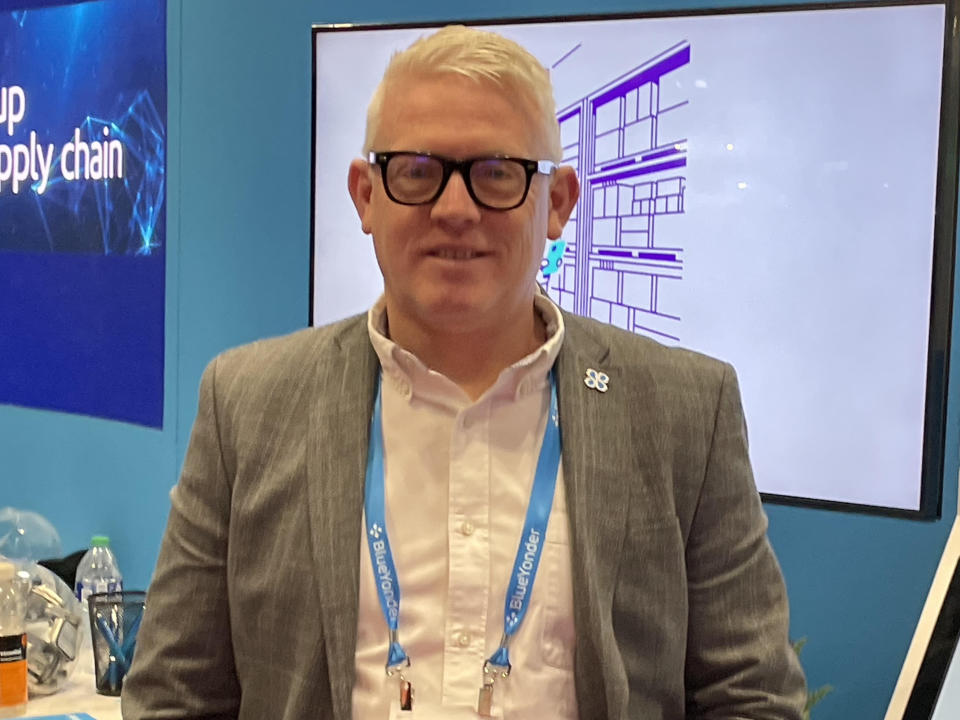3 supply chain software providers tell their latest stories at NRF

NEW YORK — The National Retail Federation is not a supply chain conference per se. But it might as well be.
A walk through the gigantic two main exhibition floors at the Jacob K. Javits Center brings the NRF attendees to a line of displays, many of them enormous, that seem to focus heavily on a definition of supply chain that encompasses not just getting products to retail outlets, but also to the final mile and final handling that put a product into the hands of consumers.
That is why three heavyweights of the supply chain — Manhattan Associates, Blue Yonder and the newly created AWS Supply Chain segment of Amazon Web Services — set up shop on those floors to tout their offerings, some of which have recently gone through significant additions or overhauls.
Two companies visited by FreightWaves at the NRF meeting have new initiatives: Blue Yonder through its acquisition in October of Doddle, a U.K. company that specializes in reverse logistics; and AWS Supply Chain, launched early last year primarily as an inventory management tool.
Also in one of the larger booths, Manhattan Associates (NASDAQ: MANH) is a supply chain software provider that is publicly traded and that in the past 52 weeks has seen its stock soar by more than 76%.
Blue Yonder: Tackling the tricky issue of returns
The Blue Yonder acquisition of Doddle was notable on several fronts, in particular the fact that this supply chain software behemoth is now going to be interacting with a part of commerce it hadn’t previously dealt with directly: the buyer or gift recipient of a product he or she no longer wants. That sort of one-to-one contact point didn’t exist before in the Blue Yonder world, according to Tim Robinson, the co-founder and CEO of Doddle and now a vice president with Blue Yonder.
Robinson described a process in most supply chains in which handling of returns was generally somewhat disorganized, enough to disrupt other parts of the supply chain that might otherwise have been well structured. That returns are an issue in the supply chain could easily be discerned from walking through the NRF floor; numerous companies touted returns services.
“In the vast majority of cases, consumer returns are arriving back at warehouses blind,” Robinson said. A consumer likely took a label off the initial packaging, slapped it on some sort of packing and sent it off via FedEx, UPS or the U.S. Postal Service. Before receipt of the package, there is no data or signal to the warehouse that the return is on its way. For a well-oiled supply chain, this is a significant instance of throwing a wrench in the gears.
“It’s just a hugely inefficient way of running warehouses,” Robinson said. So from the perspective of a freight company looking downstream from its perch on its supply chain, returns might seem miles away from the company’s own issues, but Robinson painted a picture in which reverse logistics can back up into broader operations.

One example is how the method of returns impacts supply chain costs. Robinson said if a return is sent back to the warehouse through a company like FedEx, it costs far more than if it is sent back to a retail outlet where it is easier to inject it into a supply chain that includes a warehouse.
Blue Yonder is looking to Doddle to help customers find ways to direct returns into those lower-cost channels, if possible, because that then has an impact on overall inventory levels.
The data that comes from the Doddle/Blue Yonder returns interface that will now be supplied to their customers will provide a stream of information that makes more efficient processes possible, Robinson said. Beyond finding a way to get a product back to a warehouse more efficiently, Robinson said that interface can also help the supply chain determine “where the item sits in its lifespan.” “If this is an item that has a six-week sales cycle, we know we don’t need to rush that item back in 24 hours,” he said.
Robinson contrasted the system of returns in most warehouses with Blue Yonder’s other offerings. “We have transport management tools which say you’re at the point where you’ve now decided where you’re going to put these products, then we can schedule trucks on docks, the drivers and the workforce to be able to make that happen,” he said.
What Blue Yonder didn’t have, he added, was “the tool that deals with the return and reverse logistics.” Hence the Doddle acquisition.
Manhattan Associates: Post-COVID, companies look to upgrade
Rob Schaefer is the vice president of transportation management sales at Manhattan Associates. Schaefer said Manhattan’s TMS offering among its enormous suite of supply chain products is targeted toward larger companies with an annual freight-under-management figure of $25 million.
“We’re looking at higher freight spends, and we’re looking for complexity,” Schaefer said of the average Manhattan client. “And what I mean when I say complexity is I’m looking for all modes of transportation. I’m looking for ocean, air, truckload, LTL, intermodal. I want inbound and outbound.”
Manhattan Associates’ solutions are built on its Manhattan Active Platform.
Schaefer said the company is seeing an increase in potential TMS clients who found themselves trying to get through COVID with more antiquated systems, including spreadsheets. These companies weren’t reaching out to Manhattan Associates during the pandemic because “they’re just trying to get capacity going ‘and I don’t care what it costs.’ So the uptick is post-COVID.”
But with COVID in “the rearview mirror, now is when we’re seeing a lot more happening with our TMS system,” Schaefer said.
In that review of how supply chains handled COVID, Schaefer said many companies realized that “all the systems we had didn’t talk to each other. That wasn’t good.” Another realization was that some parts of a supply chain might still have been on spreadsheets.
“So now they’re looking at it from a holistic perspective,” he added. The Active system bills itself as that type of “single solution.” “We’re not writing the integration between things,” he said, with tools that bring together different systems; Manhattan’s approach would be to put everything on the one Active platform.
Manhattan Associates also used the occasion of the NRF conference to announce several initiatives. One is a Fulfillment Experience Insights dashboard, giving real-time updates on fulfillment. A second is a Point of Sale application for use in a store. The third is a joint venture with e-commerce platform Shopify (NYSE: SHOP). The capabilities of the two companies will work in tandem to serve the e-commerce needs of retailer clients.
AWS Supply Chain: A new initiative from the giant
AWS Supply Chain hasn’t been around even a year. Its formation under the banner of Amazon Web Services (NASDAQ: AMZN) was announced in late 2022, and it commenced operations in April 2023.
The announcement was boilerplate. AWS Supply Chain “helps businesses increase supply chain visibility to make faster, more informed decisions that mitigate risks, save costs, and improve customer experiences.” What that doesn’t reveal is that its focus is very much on inventory.
Diego Pantoja-Navajas, vice president of AWS Supply Chain, said at the NRF meeting that “what we have learned the most from our customers is that they were either overstocking themselves or understocking themselves.” Pantoja-Navajas also said AWS customers found that they often had just-in-time inventory practices, which may have worked for years but were a disastrous policy in the post-pandemic months when there were short supplies of so many items.
The basic process used by AWS Supply Chain is to take disparate data that an enterprise is generating through its potentially multiple enterprise resource planning (ERP) software systems and aggregate what the data is showing about inventories.
Pantoja-Navajas used SAP as an example of a company whose processes a warehouse or intermediate supplier of goods might be using for various ERPs. The customers for Amazon Supply Chain, Pantoja-Navajas said, “would have all their supply chain data in SAP, the vendors, the facilities, the products, the purchase orders, the inventory and all that,” he said. What Amazon Supply Chain does is provide a “connector” to SAP “and extracts all the information from SAP into AWS Supply Chain. That data is then fed into a “data lake which is created to store any supply chain data.”
A demonstration of the system at the AWS booth at NRF showed a mockup of a screen with inventory levels and notifications of possible excesses and shortages. “It’s going to look at inventory throughout your network wherever it is deployed,” Pantoja-Navajas said. “That’s whether it’s a warehouse or distribution center of a manufacturing facility.”
AWS Supply Chain already has rolled out new services in its product. Announced in late November, the products bring generative AI to the Supply Chain product, data on carbon emissions of shipments, and two forecasting tools: Supply Planning and N-Tier Visibility.
In much the same way that Schaefer talked about post-pandemic analysis driving customer behavior at Manhattan Associates, Pantoja-Navajas was asked what took AWS so long to produce a product when the need seemed obvious. “I think that more than anything, COVID left a lot of companies wanting to get better and build a much more resilient supply chain for their own use,” he said.
And with the extensive reach of AWS, “data was there from the relationship with partners; relationships with partners existed, so we learned a lot from that event.”
More articles by John Kingston
From pandemic chaos to AI, supply chain panelists have seen it all lately
Supreme Court rejects review in broker liablity case, leaving the issue unresolved
SoCal warehouse emissions rule and possible impact on trucks upheld by judge
The post 3 supply chain software providers tell their latest stories at NRF appeared first on FreightWaves.
